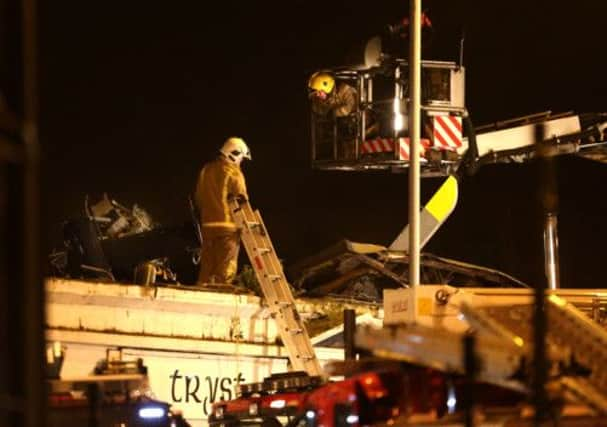Mechanical fault theory in Clutha helicopter crash


David Learmount, operations and safety editor of aviation publisher Flight Global, said: “Something dramatic has probably suddenly occurred – probably a mechanical failure of some kind. I think what has happened here is that you have had an aircraft that became either uncontrollable or partially controllable.”
Another theory put forward yesterday was the possibility that the Eurocopter EC135 could have run out of fuel, which might have explained why the crash did not result in an explosion.
Advertisement
Hide AdAdvertisement
Hide AdBut a pilot discounted the theory, claiming it was the helicopter’s crash-resistant fuel tanks that could have prevented an explosion.
Mike Buckley, a North Sea helicopter pilot, said it was “extremely unlikely” the helicopter had run out of fuel because the aircraft has a low fuel warning system and secondary tanks. It was also only two miles away from its base beside the Scottish Exhibition and Conference Centre when it crashed.
“Pilots do not fly on low fuel,” he said.
Buckley said the helicopter had crash-resistant fuel tanks, fitted with rubber bladders to prevent fuel spillage. He added that additives in the fuel acted as anti-misting agents which dampened down the fuel vapour which ignites in fires and explosions.
The pilot, from the British Airline Pilots Association, said: “You see helicopters crashing and exploding in flames in films, but this is actually rare, and a crash is unlikely to cause an immediate fire.”
He said the helicopter pilot may also have had time to pull the fuel control levers, shutting off the fuel supply.
He said: “The pilot might have had a few seconds and it would have been one of the first things they would do, but they would have had to take their hands off the controls.”
Buckley declined to speculate on the likely cause, but said: “You cannot rule out anything out, including mechanical failure or pilot error.”
But he warned against reading too much into eyewitness accounts, as they had frequently proved inaccurate. “Reports of the helicopter ‘spluttering’ or backfiring would not be correct – helicopters do not do that. Their engines are either operating or not.”
Advertisement
Hide AdAdvertisement
Hide AdBuckley said it was not clear if the helicopter had a flight data recorder fitted, because the aircraft may have been below the minimum weight to be required to have one. This is because of the extra expense and difficulty of installing the necessary sensors in smaller helicopters.
However, Buckley said the helicopter may have had other equipment installed, such as a CPDS cockpit display system, which also recorded flight details.
Learmount said helicopters had the ability to glide, which is known as “autorotation”, but “this helicopter was unable to do that”.
He said: “If we listen carefully to what the witnesses have been saying, it doesn’t sound as if this helicopter was, at the end, able to glide. Something happened very suddenly and the pilot either had no control or very little control.”
Aviation analyst Sean Maffett said if the helicopter’s gearbox had seized up the pilot may have tried to slow down its rate of descent before impact. “There is a remote possibility the pilot could have been trying to make a forced landing on the roof of this pub. But if he had had a seized gearbox and the rotor was not going round, that would not have been available to the pilot.”
Maffett said the twin-engined helicopter had more than one fuel tank and there would have been fuel in at least one of them.
Learmount agreed that a “great deal of information” could be recovered from such sophisticated instruments with which police helicopters are equipped.
Buckley stressed the helicopter model had a “very good” safety record. He said it was the aircraft of choice for police forces across the world, with some 1,000 in service. It also comprises 25 per cent of the air ambulance fleet globally.
Advertisement
Hide AdAdvertisement
Hide AdDr Simon Mitchell, of Cranfield University, said the way police helicopters operated could be a key factor.
He said: “Hovering at low speed is very power intensive – in that phase of flight, power is the key.”